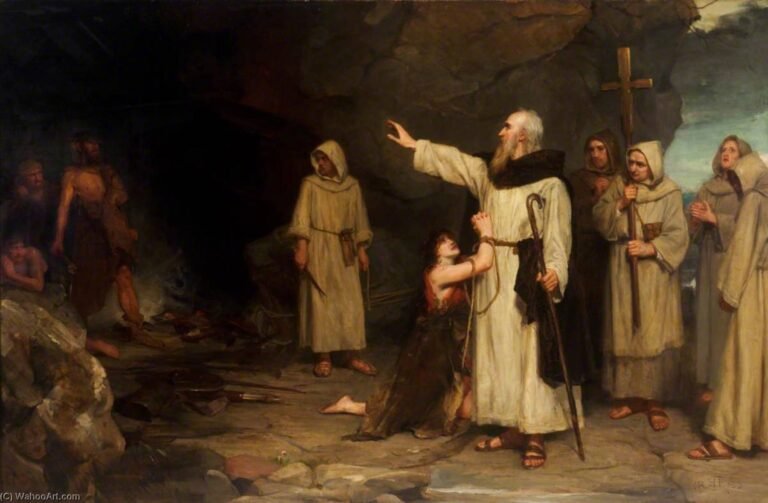Contenus
ToggleIn short
Saint Columba or Colmcille (December 7, 521 – June 9, 597 AD) was an abbot Irish et évangéliste missionnaire crédité d’avoir répandu le christianisme dans ce qui est aujourd’hui l’Scotland at the start of the Hiberno-Scottish mission. He founded the important Iona Abbey, which became a dominant religious and political institution in the region for centuries. He is the patron saint of Derry. He was highly regarded by both the Dál Riata Gaels and the Picts, et on se souvient aujourd’hui comme un saint catholique et l’un des douze apôtres d’Irlande.

Saint Columba, missionary of Scotland
In 563 he traveled to Scotland with twelve companions (said to have included Odran of Iona) in a leather-covered wicker currach. According to legend, he first landed on the Kintyre peninsula, near Southend. However, still being in sight of his native land, he moved further north to the west coast of Scotland.
The island of Iona was given to him by his kinsman Conall mac Comgaill, king of Dál Riata, who may have invited him to come to Scotland in the first place. However, there is a sense in which he was not leaving his native people, as the Ulster Gaels had colonized the west coast of Scotland over the previous two centuries.
In addition to his services in guiding the only literacy center in the region, his reputation as a holy man led him to play the role of diplomat among the tribes. There are also many stories of miracles he performed during his work to convert the Picts, the most famous being his encounter with an unidentified animal that some have likened to the Loch Ness Monster in 565.
He is said to have banished a fierce "water beast" to the depths of the River Ness after killing a Pict and then attempting to attack Columba's disciple named Lugne.
He visited the pagan king Bridei, King of Fortriu, at his base in Inverness, gaining Bridei's respect, but not his conversion. He later played a major role in the country's politics. He was also very energetic in his missionary work and, as well as founding several churches in the Hebrides, he worked to transform his monastery at Iona into a school for missionaries.
He was a renowned man of letters, having written several hymns and being credited with transcribing 300 books. One of the few, if not the only, times he left Scotland was towards the end of his life, when he returned to Ireland to found the monastery of Durrow.
According to traditional sources, Saint Columba died at Iona on Sunday June 9, 597 and was buried by his monks in the abbey he established. However, Dr. Daniel P. Mc Carthy disputes this and assigns a date of 593 to Columba's death. The Annals record the first raid made on Iona in 795, with further raids occurring in 802, 806 and 825. The relics of Saint Columba were finally removed in 849 and divided between Scotland and Ireland.
Les parties des reliques qui sont allées en Irlande sont réputées enterrées à Downpatrick, dans le comté de Down, chez Saint Patrick et Brigid of Kildare ou à l’église Saul voisine de Downpatrick. (Noms d’Iona), Inchcolm et Eilean Chaluim Chille.
Social networks
Aujourd’hui, les Ecossais célèbrent saint Colomba. Cet émissaire irlandais a introduit le christianisme dans le nord de l’Angleterre, notamment sur l’île de Iona où il créa son ordre monastique. #mythology #myth #legend #calendar June #9 #SaintColumba
Picture
